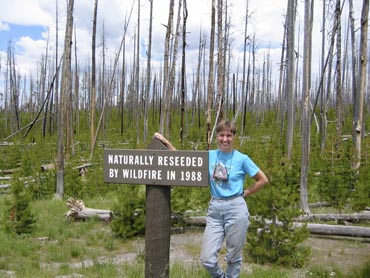Patterns in changing ecological landscapes inspire professor
Monica Turner first visited Yellowstone National Park as a ranger naturalist in the summer of 1978, sent by the Student Conservation Association to lead nature walks and campfire programs. A city kid from New York, she enjoyed the outdoors and was excited for her first trip out of the Northeast.

On July 14, 2004, Monica Turner, professor of zoology at the University of Wisconsin–Madison, stands in front of a naturally regenerated forest in Yellowstone National Park, a site previously ravaged by massive wildfires in 1988. The small trees pictured are about 15 years old and likely germinated after the 1988 fires. The still-standing dead trees were killed by the fire, but had not yet fallen when the photo was taken. Turner is an ecology expert who is continuing to study the aftermath and long-term forest recovery from the ’88 Yellowstone fires.
Photo: courtesy Monica Turner
See also: Rising from the ashes: The science of Yellowstone’s rebirth
At the time, she was a junior at Fordham University in the Bronx contemplating future career choices in the life sciences. “As a college student, I was majoring in biology, uncertain about whether I wanted to do veterinary medicine or ecology,” she says. Surrounded that summer by the grandeur of the Rockies and the natural history of America’s first national park, Turner chose a path toward ecology.
Thirty years later, she has established herself as a leader in the field and made Yellowstone one of the most well-studied ecological landscapes in the country.
Turner’s research in the University of Wisconsin–Madison zoology department examines how large-scale environmental changes affect ecological processes. Her emphasis on the importance of spatial patterns in the environment laid the groundwork for a new discipline, known as landscape ecology.
Being at the forefront of a new field provided both opportunities and challenges. Her research questions — many of which relied on natural events that could not be repeated — did not fit the standard mold of scientific experiments.
“I had reviews back in those times from manuscripts or proposals with reviewers saying, ‘This isn’t science, this is pseudoscience because it can’t be replicated,'” Turner recalls. In response, she developed new methods that apply rigorous scientific standards to study what she calls “natural experiments.”
Her efforts paid off. Now recognized as one of the founders of landscape ecology, she co-authored in 2001 what remains a definitive textbook on the subject. She was elected to the National Academy of Sciences in 2004, named the Eugene P. Odum Professor of Ecology in 2005, and this summer received the Robert H. MacArthur Award from the Ecological Society of America, one of the highest awards in her field. This fall, she will become the first woman to receive the distinguished ECI Prize from the International Ecology Institute, awarded for sustained outstanding achievements in ecology.
Among her peers, Turner is best known for her extensive body of work on forest fires in Yellowstone National Park, where she has conducted the first long-term study of how a major ecological disturbance can shape an ecosystem over space and time. She also has active research programs examining how historical land use patterns have influenced southern Appalachian forests and studying ecosystems at the interface between land and water in Wisconsin’s Northern Highlands Lake District.
No matter where she is working, though, her collaborators praise her efficiency, thoughtfulness and the breadth of her scientific vision.
“The thing that I appreciate about working with her is her ability to be interdisciplinary, bring a lot of different ideas together, and to put together teams that work well together that are able to address the questions in ways that play to everybody’s strengths,” says forest and wildlife ecology professor Phil Townsend.
“She covers all fronts. She’s a nice person to be around, she’s cheerful, she’s friendly,” says Dan Kashian, a former graduate student of Turner’s who is now an assistant professor at Wayne State University. “And on top of it all, she’s done this while having two kids.”
Turner also is an active member of the ecology community at UW–Madison and is an accomplished mentor and teacher.
“The thing about Monica is that she’s very good at knowing what it takes to succeed,” Kashian says. “As an adviser, she had a lot of advice on what it takes to do well, and I haven’t come across a situation yet where that advice was incorrect.”




